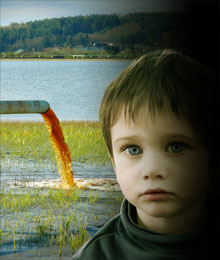An Uncertain Tomorrow: Our Toxic Reality
April 16, 2009 by City Life Staff
Filed under Green Living, Health
 Humankind’s precarious future depends on what we’re doing to our bodies today.
Humankind’s precarious future depends on what we’re doing to our bodies today.
After watching a recent CBC documentary called “The Disappearing Male,” I was shocked to discover not just what we’ve done to our planet, but what we’re doing to ourselves – and it’s affecting our very survival. It seems global warming isn’t our only worst enemy. Believe it or not, humankind is just beginning to discover a new threat, and it’s found in everyday products like canned goods, shampoos, baby bottles, and in our air and water. Some 90,000 man-made chemicals have been developed in the last 60 years, and now they’re slowly being linked to a major decline in male births. In the last 30 years alone, three million fewer baby boys have been born. This emerging issue, which few people have heard about, prompted me to ask some serious questions.
I decided to fire off a barrage of e-mails to several reproductive health doctors in Ontario, and occupy myself with some research while waiting for a reply. An article called An Inconceivable Truth in Vogue magazine caught my eye. Similar to the CBC’s documentary, it talked about a group of toxins known as endocrine disrupters (EDCs), which can affect human hormonal systems, altering male fetus genital development, testicular size, and sperm quality. One example, chemical agents called phthalates, are found in bendable plastics and cleaning products. Another toxin, known as bisphenol A (BPA), is commonly found in dental sealants and canned vegetables. BPA was banned in Canada eight months after Vogue published its article.
Digging for more, I eventually interviewed several medical experts. According to Dr. Paul Claman,
co-founder of the Ottawa Fertility Centre, “There has been a dramatic decline in the quality of sperm over the last 100 years, and it likely has to do with environmental and industrial toxins.” His study Men at Risk: Occupation and Male Fertility discusses some of the many possible causes. “I think pesticides and phthalates are really a drop in the bucket, in an ocean of all kinds of toxins that have been around a lot longer,” he says. “All the information we’ve got is based on public health studies, but the problem is, they don’t really allow absolute proof because there are so many variables.”
A lack of data seems to be the ongoing consensus. “We don’t know how much is due to what, because fertility across the world is very variable,” says Dr. Keith Jarvi, director of the Murray Koffler Urologic Wellness Centre at Mount Sinai Hospital. “Basically, it’s a mess,” he says, pointing out, “We really don’t know what it is in the environment, apart from some really obvious things.” But even some of the obvious, already-banned chemicals can have long-lasting consequences. The compound called diethylstilbestrol (DES) was given to women in the mid-20th century to prevent miscarriages until it was prohibited for causing cervical cancer. And more effects are still being felt today, according to Dr. Peter Chan, director of male reproductive medicine at the McGill University Health Centre. “It turns out that baby boys who had been born to mothers using this medication had all kinds of negative impacts on their reproductive health, including infertility, testes cancer, and undescended testicles. “I think further research is important and the Canadian Institute for Health Research has already launched a big initiative to look at environmental effects on reproductive health.”
At the very least, we should hope governments and organizations everywhere are looking into the issue, and for the most part, they are. One of the best examples comes from the European Union, with a regulation initiative called REACH. It deals with the registration, evaluation, authorization and restriction of chemical substances. To date, many European countries have already banned chemicals that are still being used in North America. The Washington-based Environmental Working Group is another worthwhile organization. Its recent study found 38 harmful chemicals in 10 brands of packaged water, including Wal-Mart’s, as a result of some toxins leaking from their plastic bottles. The findings are part of a number of worldwide studies, which are reviving the glass bottle industry, and making people think twice about buying packs of water commonly found outdoors at gas stations, cooking in the sun.
All of these initiatives are reassuring, although I can’t help but wonder: Is there anything we haven’t been told? I’m generally an optimistic person, but a gut feeling of doubt kicked in when I started e-mailing different doctors and got a phone call from Health Canada only 20 minutes later. Its media relations senior advisor wanted to know what I would be writing, and asked me not to contact any doctors directly, since it was easier for him to arrange interviews. Having worked in government public relations, I can say this is a common practice, although it was the first time anyone returned my messages with stellar speed and curiosity.
That aside, while studies continue we can make certain considerations based on what we know. In fact, the University of Windsor’s Dr. Jim Brophy knows quite a bit on the subject. He studied the decline in male births near areas surrounding petrochemical plants in Sarnia. “We’ve got a situation where almost the whole human population has a level of exposure, so I think we have to really take a look at putting the onus on the manufacturers to properly test these compounds,” he says. Unlike medicines that are tested before being released, chemicals have largely been tested for short-term – not long-term – effects by the chemical industry. “When we discover these compounds act as hormonal disruptors, there has to be every effort to get them out of our products.” In addition to awareness, a variety of other solutions are available.
While it’s impossible, at least for now, to separate ourselves from our environment, we can take precautions to minimize chemical exposures. In workplaces where degreasers and fumes are present, using gloves and proper ventilation can make a colossal difference. And when in doubt, go organic. “Green leafy veggies to get your dose of folic acid, as well as whole grains, nuts and seeds, fresh water fish, organic chicken and berries are a great way to start,” says Dr. Tanya Wylde, naturopathic doctor and fertility specialist at the Vaughan Medical Centre. “Arginine, carnitine, zinc, and vitamins C, E, and B12 also play a heavy role in the health of sperm.” Home products like hair dyes, canned foods, and industrial paints can be substituted with natural beauty products, fresh, frozen or dried foods and organic paints. The old-fashioned tradition of opening windows is a great way to replace air fresheners, and using a reliable water filter can heavily reduce contamination. Men, in particular, can remember to have regular urological checkups, since there are usually no signs of impaired fertility. The most important solution involves maintaining a healthy diet and regular exercise.
Looking at how long it took humankind to realize its effects on the environment, it can be a scary thought to wonder what else we’re doing to our bodies. It’s probably even more frightening to think that one day the entire human population could become infertile and cease to exist. If anything is clear, it’s that we don’t want to wait another 30 years to discover the consequences of our actions. Clearly, the time to wake up and take better care of the planet is now. It will mean the difference between remaining our Earth’s permanent keepers or fading away as vagrants passing through a foreign city.







Comments
Feel free to leave a comment...
and oh, if you want a pic to show with your comment, go get a gravatar!